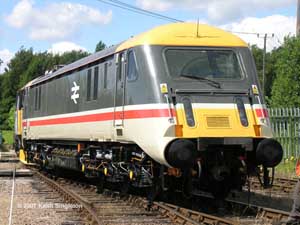|
|
In the early 1980s the long-delayed electrification of the East Coast Main Line (ECML) was put back on the agenda. The original rolling stock plan was for locomotive-hauled trains formed of new locomotives and a new build of Mk3 coaches. In response to the plan, Brush designed a completely new electric locomotive and built a "production prototype" (the mechanical construction was sub-contracted to BREL Crewe) which became the one and only Class 89, 89001.
This loco appeared in 1986 and bore no resemblance to its predecessors. It had two streamlined cabs similar to the HST, a Co-Co wheel arrangement (as opposed to the Bo-Bo of all previous AC designs), and a 125 mph top speed. The body was profiled to match the Mk3 carriage design and it was fitted with buckeye couplers and rubbing plates (another first for an AC electric). Brush envisaged a fleet of 89s for the ECML, but the loco was also capable of handling heavy freight services, so could theoretically provide modern traction for passenger and freight on the West Coast route too. The opportunity to standardise and modernise the fleets on Britain's two main north-south arteries was there for the taking.
Sadly, before fleet production could get underway (and indeed before the prototype even took to the rails) British Rail's policy towards the new ECML stock had changed in favour of fixed-formation trainsets, with a Class 91 Bo-Bo locomotive semi-permanently attached at one end of a rake of Mk4 coaches; and a new top speed of 140 mph. This effectively ruled out the 89, which could only reach 125 mph.
A production fleet never materialised, but the design paved the way for Brush to build the Eurotunnel Class 9s and the International Class 92s several years later. Ironically, the Class 91s that were built for the ECML have never been allowed to run above 125 mph in regular service after all.
 89001 at Barrow Hill
89001 at Barrow Hill